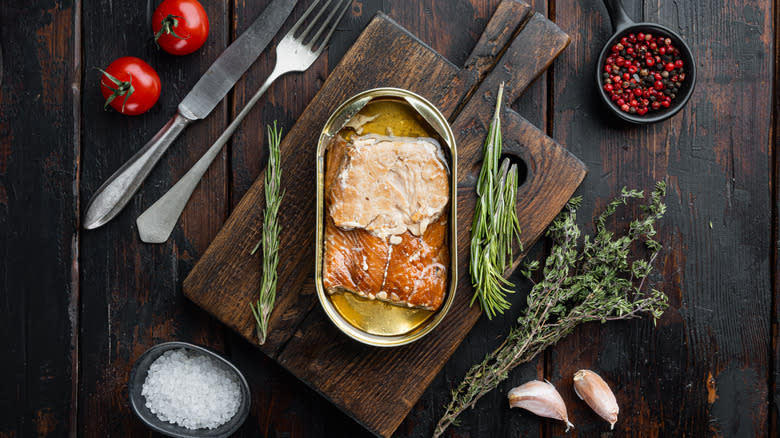Should You Drain Canned Salmon Before Eating It?

We may receive a commission on purchases made from links.
If you want to increase how much fatty fish you eat but are strapped for time when it comes to dinner prep, canned salmon is an excellent option. This healthy and convenient food is low in calories, high in omega-3 fatty acids, and contains many essential vitamins and nutrients. Canned salmon also contains high concentrations of sodium, particularly when the fish is packed in salt water. That's why it's recommended that you drain the salmon before eating it.
A can of salmon can contain over 400 milligrams of sodium, which is about 17% of a person's recommended daily sodium intake, per the FDA. As many foods contain salt, keeping your sodium intake low is important to maintaining good health; removing the liquid the fish is packed in is one way to manage salt levels in your diet. However, some people worry that draining salmon eliminates some of its nutrients, especially when it comes to omega-3 fatty acids. Fortunately, you can reduce its sodium content without drastically affecting canned salmon's nutritional benefits.
Read more: 12 Underrated Types Of Fish You Should Try At Least Once
Draining The Liquid Shouldn't Impact Nutritional Value

Canned foods are subjected to high temperatures to kill germs and bacteria; this is why canned salmon and other shelf-stable foods have a long shelf life. While beneficial for preserving salmon, heat can also reduce some of its nutritional value, as the omega-3-rich oils in salmon will break down and leach into the liquid as they heat up.
Despite this minor leaching of nutrients, canned salmon retains lots of its oils, which means a large portion of omega-3s remain in the fish. Because these oils are not highly water soluble, the nutrients are less likely to be washed away by rinsing. So, while draining and rinsing the fish minorly impacts its nutritional value, it doesn't eliminate the numerous benefits canned salmon provides.
According to the American Heart Association, a diet containing fatty fish like salmon can effectively reduce a person's heart disease risk. Canned salmon is also packed with its bones intact, which are delicate and don't negatively affect the texture of the fish. Per Healthline, these bones increase a person's calcium intake to ensure stronger teeth and bone tissue.
Another Benefit Of Draining Canned Salmon

Beyond nutritional concerns, removing the liquid from salmon will eliminate the pungent odor that sometimes accompanies canned fish. While canned salmon is lauded for its rich texture and subtle sweetness, the liquid in the package may have a fish-forward scent that not everyone enjoys. Fortunately, draining and rinsing the fish reduces this scent, allowing you to focus on the sheer deliciousness of the salmon.
Keep in mind that not all brands of canned salmon are created equal. As quality decreases, the smell of canned salmon may intensify. This is because some brands use lower-quality or less fresh fish, which can negatively affect taste, texture, and odor. Wild-caught salmon of the Alaskan, pink, sockeye, and red varieties tend to be the highest quality. Always check the label if you're unsure what you're buying.
Also, consider that there are different types of salmon, and flavors will vary according to which you choose. For instance, sockeye is known for its intense flavors, while coho has a subtler flavor profile. Atlantic salmon, the most prevalent on store shelves, is often said to have a buttery texture and taste. By choosing your canned salmon carefully, you are better able to enjoy a meal that is equal parts convenient, nutritious, and delicious.
Read the original article on Daily Meal.

 Yahoo Finance
Yahoo Finance 